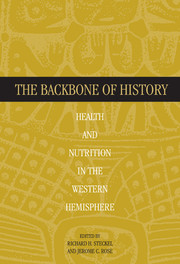Book contents
- Frontmatter
- Contents
- Preface
- List of Contributors
- PART I
- PART II METHODOLOGY
- PART III EURO-AMERICANS AND AFRICAN-AMERICANS IN NORTH AMERICA
- PART IV NATIVE AMERICANS IN CENTRAL AMERICA
- PART V NATIVE AMERICANS AND EURO-AMERICANS IN SOUTH AMERICA
- PART VI NATIVE AMERICANS IN NORTH AMERICA
- Introduction
- 14 A Biohistory of Health and Behavior in the Georgia Bight: The Agricultural Transition and the Impact of European Contact
- 15 Native Americans in Eastern North America: The Southern Great Lakes and Upper Ohio Valley
- 16 Cultural Longevity and Biological Stress in the American Southwest
- 17 Health, Nutrition, and Demographic Change in Native California
- 18 Welfare History on the Great Plains: Mortality and Skeletal Health, 1650 to 1900
- PART VII
- PART VIII
- PART IX EPILOGUE
- Index
17 - Health, Nutrition, and Demographic Change in Native California
Published online by Cambridge University Press: 01 March 2010
- Frontmatter
- Contents
- Preface
- List of Contributors
- PART I
- PART II METHODOLOGY
- PART III EURO-AMERICANS AND AFRICAN-AMERICANS IN NORTH AMERICA
- PART IV NATIVE AMERICANS IN CENTRAL AMERICA
- PART V NATIVE AMERICANS AND EURO-AMERICANS IN SOUTH AMERICA
- PART VI NATIVE AMERICANS IN NORTH AMERICA
- Introduction
- 14 A Biohistory of Health and Behavior in the Georgia Bight: The Agricultural Transition and the Impact of European Contact
- 15 Native Americans in Eastern North America: The Southern Great Lakes and Upper Ohio Valley
- 16 Cultural Longevity and Biological Stress in the American Southwest
- 17 Health, Nutrition, and Demographic Change in Native California
- 18 Welfare History on the Great Plains: Mortality and Skeletal Health, 1650 to 1900
- PART VII
- PART VIII
- PART IX EPILOGUE
- Index
Summary
ABSTRACT
Before the arrival of Europeans, California was inhabited by Native Americans with a diverse array of cultural adaptations that varied markedly through time and space. A few regional differences and weak temporal trends can be discerned in the health status of Californias prehistoric inhabitants. However, the overall pattern suggested by the available bioarchaeological data is one in which health conditions greatly diverged through time within different geographical areas. Short-term declines in health status linked to fluctuations in local environmental productivity appear to have been common. Skeletal studies suggest a tendency during the prehistoric period toward declining health among the inhabitants of the densely populated Santa Barbara Channel and Sacramento Valley regions. In both areas, evidence of growth disruption and infectious disease increases significantly between the Early and Late Periods. Skeletal data and paleoenvironmental records suggested that in some areas, living conditions declined substantially around the end of the first millennium owing to climate-induced fluctuations in marine and terrestrial productivity. Although conditions improved significantly in some areas during the Late Period, the arrival of Europeans marked the beginning of a spectacular population decline. By the end of the nineteenth century, the combined effects of epidemics, genocide, and social disruption had reduced the once thriving Californian Indian population to a few thousand individuals. During the last half of the twentieth century there has been a remarkable reversal of this trend toward population decline, owing to improved living conditions on reservations and the immigration of large numbers of Indians from other states to Californias urban centers.
- Type
- Chapter
- Information
- The Backbone of HistoryHealth and Nutrition in the Western Hemisphere, pp. 506 - 523Publisher: Cambridge University PressPrint publication year: 2002
- 8
- Cited by



